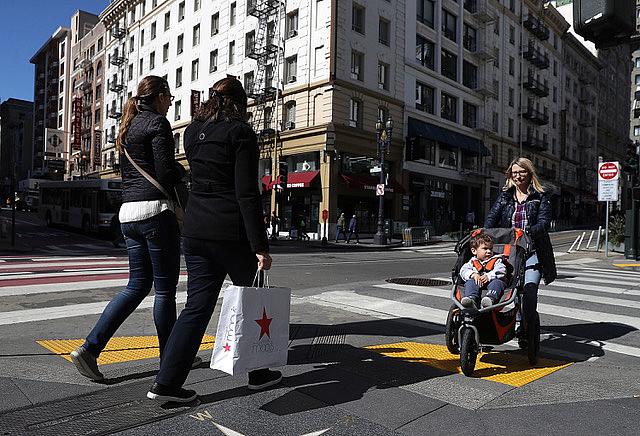Keeping kids out of the doctor’s office much easier in well-off neighborhoods

San Francisco residents wait in line for a food basket giveaway. (Photo by Justin Sullivan/Getty Images)
Researchers are increasingly discovering how much neighborhoods impact life trajectories. That’s even more true for kids.
Ellen Kersten, a population health researcher at the University of California, San Francisco, has been exploring how urban environments affect public health for years. In 2014, she found that children who lived in redeveloped public housing were less likely to have repeat visits to the emergency room compared to children who lived in lower-quality public housing.
“There is a rapidly developing literature about how health care providers can screen for and help mitigate social barriers to health,” said Kersten.
In a new study out in the journal Pediatrics, Kersten and colleagues used a measure called the Child Opportunity Index, created by researchers at Brandeis University, to figure out how neighborhoods were associated with pediatric acute care visits. The index uses 19 measures from publicly available census data across 100 large metropolitan areas across the U.S.
Researchers identified clusters of high- and low-risk neighborhoods in San Francisco. And she found some stark differences: children living in the lowest opportunity neighborhoods were four times more likely to visit acute care in a year compared with those in the highest opportunity neighborhoods.
So what, exactly, does a low-opportunity neighborhood look like? Kersten outlined some common qualities: proximity to toxic waste sites, few health food retail locations, a long distance to parks or greenspace, few licensed early childhood education centers, a high foreclosure rate, and few job opportunities within five miles. She warns that the study only looked at associations, not causation, between neighborhood features and health outcomes. In other words, she can’t say these factors are causing more acute care visits.
In the Dogpatch neighborhood of San Francisco, for example, incomes are considered moderate for the city. However, the Child Opportunity Index identifies it as a low-opportunity neighborhood — the health needs of the community could be overlooked by policymakers only focused on income levels.
Kersten says her latest findings should provide fresh impetus for health care systems and providers to collaborate with community organizations and agencies outside of the health care setting to address health disparities. Tools such as the Child Opportunity Index can serve as a screening tool to identify at-risk communities.
Although the study didn’t set out to examine race as a factor, Kersten noted that more than three out of every four African American or Latino patients in the study’s sample lived in a low- opportunity neighborhood, compared with just one out of every four white patients. And 82 percent of publicly insured patients lived in low-opportunity neighborhoods, compared with 27 percent of privately insured patients.
“We need interventions directly in low-opportunity neighborhoods to make a dent in these disparities,” Kersten said.
Those interventions would vary by neighborhood and should be guided by community input but could include investments in public schools and day cares, improving access to healthy food and parks, and expanding local hiring and housing assistance programs.
Kersten is continuing her work, looking at health outcomes before and after neighborhood revitalization projects occur. She wants to know how the downstream effects of revitalization projects. For example, what happens to health outcomes when housing, education and job training improves?
Said Kersten: “If we want to see a change in kind of racial health disparities, we also have to think broadly about the environments where people are living.”
**

